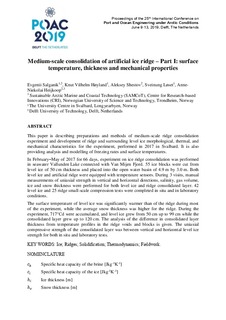Medium-scale consolidation of artificial ice ridge – Part I: surface temperature, thickness and mechanical properties
Salganik, Evgenii; Høyland, Knut Vilhelm; Shestov, Aleksey; Løset, Sveinung; Heijkoop, Anne-Niekolai
Journal article, Peer reviewed
Published version

Åpne
Permanent lenke
http://hdl.handle.net/11250/2608905Utgivelsesdato
2019Metadata
Vis full innførselSamlinger
Originalversjon
Proceedings - International Conference on Port and Ocean Engineering under Arctic Conditions. 2019, .Sammendrag
This paper is describing preparations and methods of medium-scale ridge consolidation experiment and development of ridge and surrounding level ice morphological, thermal, and mechanical characteristics for the experiment, performed in 2017 in Svalbard. It is also providing analysis and modelling of freezing rates and surface temperatures. In February–May of 2017 for 66 days, experiment on ice ridge consolidation was performed in seawater Vallunden Lake connected with Van Mijen Fjord. 55 ice blocks were cut from level ice of 50 cm thickness and placed into the open water basin of 4.9 m by 3.0 m. Both level ice and artificial ridge were equipped with temperature sensors. During 3 visits, manual measurements of uniaxial strength in vertical and horizontal directions, salinity, gas volume, ice and snow thickness were performed for both level ice and ridge consolidated layer. 42 level ice and 25 ridge small-scale compression tests were completed in situ and in laboratory conditions. The surface temperature of level ice was significantly warmer than of the ridge during most of the experiment, while the average snow thickness was higher for the ridge. During the experiment, 717°Cd were accumulated, and level ice grew from 50 cm up to 99 cm while the consolidated layer grew up to 120 cm. The analysis of the difference in consolidated layer thickness from temperature profiles in the ridge voids and blocks is given. The uniaxial compressive strength of the consolidated layer was between vertical and horizontal level ice strength for both in situ and laboratory tests.